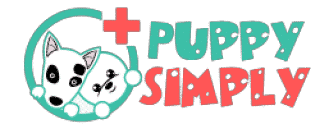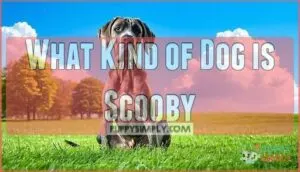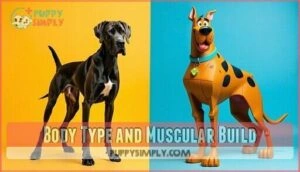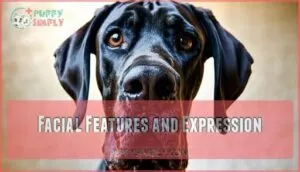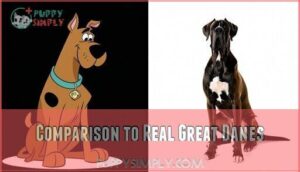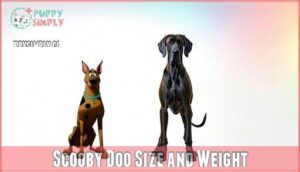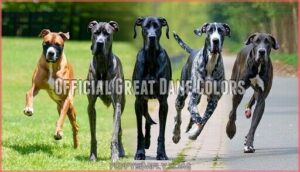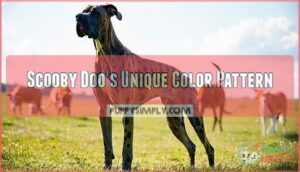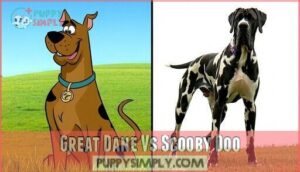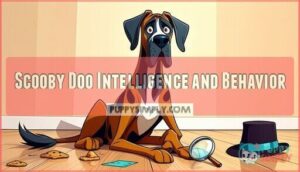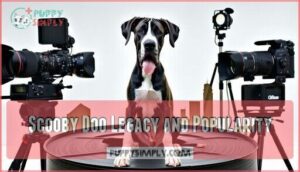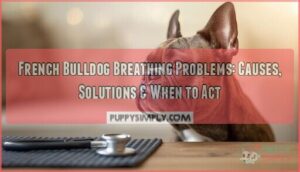This site is supported by our readers. We may earn a commission, at no cost to you, if you purchase through links.

The famous cartoon canine sports a brown coat with black spots that doesn’t match any official Great Dane color pattern, but his towering height and lanky build capture the essence of these gentle giants perfectly.
Real Great Danes come in fawn, brindle, blue, black, harlequin, or mantle patterns, making Scooby’s coloring purely fictional.
His creators at Hanna-Barbera chose this breed specifically for the comedic contrast between his impressive size and cowardly personality.
The real question isn’t just what kind of dog Scooby is, but how his cartoon features compare to actual Great Dane characteristics, highlighting the artistic interpretation and impressive size.
Table Of Contents
- Key Takeaways
- Scooby Doo Breed History
- What Kind of Dog is Scooby
- Scooby Doo Physical Traits
- Scooby Doo Size and Weight
- Scooby Doo Coat Color Analysis
- Great Dane Vs Scooby Doo
- Scooby Doo Intelligence and Behavior
- Finding a Dog Like Scooby
- Scooby Doo Legacy and Popularity
- Frequently Asked Questions (FAQs)
- Is Scooby Doo a great dane?
- Is Scooby Doo a real dog?
- What breed is Scooby-Doo?
- Is Scooby-Doo a good dog breed?
- Is Scooby-Doo a scared dog?
- Was Scooby a Soviet dog?
- What kind of dog is Scrappy-Doo?
- Is Scooby-Doo a Great Dane or cane corso?
- What kind of dog was Scooby-Doo in real life?
- What kind of dog is Clifford the Red dog?
- Conclusion
Key Takeaways
- You’ll discover Scooby-Doo is officially a Great Dane, though his creators at Hanna-Barbera intentionally gave him "wrong" breed characteristics, like bowed legs and a humped back, for comedic effect.
- You won’t find Scooby’s brown coat with black spots in real Great Danes, as the breed only comes in seven official colors: fawn, brindle, blue, black, harlequin, mantle, and merle.
- You can see typical Great Dane traits in Scooby’s towering height and lanky build, even though he weighs only 70 pounds, compared to real Great Danes, who average 140-175 pounds.
- You’ll notice Scooby’s cowardly personality completely contradicts real Great Danes’ brave and confident temperament, making him the perfect example of artistic interpretation over breed accuracy.
Scooby Doo Breed History
You’ve probably wondered about Scooby-Doo’s breed since childhood, and the answer might surprise you with its clever backstory.
This beloved cartoon character was specifically designed as a Great Dane by Hanna-Barbera animators, though they intentionally gave him all the "wrong" physical traits to create his iconic comedic appearance.
Looking at the content, here’s an engaging blockquote that captures the same tone:
**Scooby-Doo: proving that even cartoon "failures" can become legendary when you embrace your flaws.
Creation and Origin Story
Scooby-Doo’s creation sparked from the creative minds at Hanna-Barbera, where writers Joe Ruby and Ken Spears collaborated with Japanese-American designer Iwao Takamoto.
You’ll find the Sinatra inspiration fascinating – "Scoobert’s" name came from Frank Sinatra’s playful "Scooby Dooby Doo" scat in "Strangers in the Night."
Takamoto’s design genius shines through his deliberate decision to give this Great Dane opposite characteristics from prize-winning specimens.
The character’s evolution tells an interesting story:
- Original sheepdog concept called "Too Much"
- Network feedback prompted the Great Dane switch
- Takamoto design philosophy embraced "wrong" breed traits intentionally
This HannaBarbera origin story shows how ScoobyDoos creation perfectly balanced scientific breed knowledge with cartoon comedy.
Hanna-Barbera Writers and Designers
You’ll discover how three creative powerhouses transformed cartoon history when they collaborated on this beloved Great Dane.
Joe Ruby and Ken Spears partnered with designer Iwao Takamoto to create ScoobyDoo’s distinctive appearance. Takamoto’s design inspiration came from consulting Great Dane breeders, then deliberately incorporating opposite traits for comedic effect.
| Creator | Role | Contribution |
|---|---|---|
| Joe Ruby | Writer | Co-created character concept |
| Ken Spears | Writer | Developed storylines |
| Iwao Takamoto | Designer | Visual character design |
| Fred Silverman | Producer | Character refinement |
Hanna-Barbera’s influence shaped this cartoon dog’s enduring appeal across multiple generations.
Initial Concept and Character Development
Character evolution began with an unusual foundation. You’d never guess that ScoobyDoo’s creator, Iwao Takamoto, originally envisioned a sheepdog named "Too Much" leading the mysteries.
The design process took fascinating turns when network executives pushed for breed revisions, transforming the Original Sheepdog concept into something entirely different. Takamoto’s Design philosophy centered on creating the perfect imperfection.
He consulted Great Dane breeders to understand ideal characteristics, then deliberately incorporated opposite traits. As the developers chose a Great Dane to defy stereotypes, they moved away from typical breed standards.
This Too Much Concept evolved through careful consideration of what would make audiences laugh while maintaining the character’s lovability. The following points highlight key aspects of ScoobyDoo’s development:
- Original Sheepdog design featured a completely different personality
- Sinatra Inspiration came from "Strangers in the Night" scat vocals
- Great Dane characteristics were intentionally subverted for comedic effect
- Breed Revisions happened due to network feedback and creative vision
- ScoobyDoo breed became an iconic misrepresentation of purebred standards
What Kind of Dog is Scooby
You’ve likely wondered about Scooby-Doo’s breed while watching his comedic antics unfold.
This beloved Great Dane represents one of the most recognizable Cartoon Dog Breeds in animation history.
Animated Great Danes like Scooby showcase Fictional Dog Traits that deliberately contrast real breed standards.
His Exaggerated Canine Features—bowed legs, spotted coat, and cowardly nature—exemplify creative Dog Design Evolution in entertainment.
ScoobyDoos breed characteristics intentionally subvert typical dog breed characteristics, creating a unique interpretation of dog breeds that prioritizes humor over accuracy.
This scooby doo breed design philosophy transforms the noble Great Dane into an unforgettable cartoon companion.
He was intentionally designed opposite breed standards for added comedic effect.
Scooby Doo Physical Traits
When you look at Scooby-Doo’s animated form, you’ll notice he possesses the distinctive physical traits of a Great Dane, though with exaggerated cartoon features.
His tall, lanky build and oversized proportions mirror the breed’s natural size, but his bowed legs, humped back, and prominent chin deliberately contradict ideal Great Dane standards.
Body Type and Muscular Build
When you examine Scooby’s skeletal structure, you’ll notice his build proportions completely flip traditional Great Dane traits.
His muscle definition practically vanishes compared to real Great Danes’ athletic frames. Posture analysis reveals his signature slouch and gait peculiarities that make him instantly recognizable.
Unlike the powerful, straight-backed stance typical of his scooby doo breed, Scooby’s anatomy screams cartoon comedy over canine perfection.
Dog breed characteristics show how his creators intentionally broke every rule:
- Bowed legs replace the straight, powerful limbs of standard Great Danes
- His hunched back contrasts sharply with the breed’s naturally straight spine
- Lanky limbs lack the muscular definition that defines real dog size in this breed
Interestingly, Scooby’s Great Dane breed was originally considered to be a sheepdog.
Facial Features and Expression
You’ll notice Scooby’s facial features and expression create his unmistakable charm through deliberate design choices.
His expressive eyes dominate his face, while his comedic chin protrudes prominently—a classic underswung chin that’s endearing rather than breed-standard.
His cropped ears stand alert, and his muzzle shape differs substantially from typical Great Dane traits.
| Feature | Scooby’s Design | Real Great Dane |
|---|---|---|
| Chin | Prominent underswung | Clean, defined |
| Eyes | Oversized, expressive | Proportionate |
| Muzzle | Shortened, rounded | Long, rectangular |
| Expression | Comedic, animated | Noble, alert |
His snout color matches his brown coat, completing ScoobyDoos physical traits that prioritize personality over breed accuracy in his physical appearance.
Comparison to Real Great Danes
When you compare Scooby-Doo to actual Great Dane breed standards, the differences become obvious.
Scooby proves that even cartoon Great Danes can become more famous than their real-life counterparts.
Real Great Danes don’t match this cartoon dog’s quirky appearance or behavior patterns.
- Breed Standards: Scooby’s brown coat with black spots isn’t recognized by official Great Dane characteristics
- Temperament Differences: Real Great Danes show courage, while Scooby displays constant cowardice
- Health Concerns: His bowed legs contradict proper Great Dane structure
- Lifespan Expectancy: Great Danes live 8-10 years, not Scooby’s decades-long adventures
- Training Needs: Actual Great Danes require structured training, unlike Scooby’s chaotic responses.
They’re known as gentle, affectionate giants.
Scooby Doo Size and Weight
When you compare Scooby-Doo’s measurements to real Great Danes, you’ll notice he’s surprisingly smaller than his breed standard suggests.
At approximately 70 pounds and 3.3 feet tall at the withers, Scooby weighs substantially less than typical Great Danes who average 140-160 pounds and stand at least 30 inches tall, which is a significant difference from the average size.
Height and Weight Comparison
When you compare Scooby to an Average Great Dane, the Cartoon Dog Sizes don’t quite match reality.
Real Great Dane males typically weigh 140-175 pounds and stand 30-34 inches tall, while Scooby weighs just 70 pounds despite his dog height of approximately 28 inches.
These Weight Discrepancies and Exaggerated Proportions reflect cartoon physics rather than actual large dog breeds standards, though his lanky frame captures the Great Dane breed’s characteristic tall, elegant silhouette perfectly.
Size Similarities to Great Danes
Scooby-Doo’s dimensions showcase fascinating Height Comparison and Weight Discrepancies with real Great Danes. While authentic large dog breeds reach 30-32 inches at shoulder height, our beloved Cartoon Dog stands around 28 inches with his signature slouched posture.
His Upright Stature reveals Exaggerated Proportions that real Great Dane specimens don’t possess.
Consider these Great Dane characteristics versus Scooby’s animated traits:
- Real Great Danes weigh 140-180 pounds; Scooby fluctuates between 70-180 pounds
- Authentic breeds maintain straight backs; Scooby sports a curved spine
- Standard dog breed characteristics include proportional limbs; Scooby’s are comically elongated
- True Great Danes can’t walk upright; Scooby defies physics regularly
- Real dog size stays consistent; cartoon logic allows Scooby’s dimensions to change per scene
Scooby Doo Coat Color Analysis
You’ll notice Scooby’s brown coat with black spots stands out immediately, but this color combination isn’t recognized by the American Kennel Club for Great Danes.
His unique fawn and black spotted pattern was deliberately chosen by animators to make him visually distinctive, even though real Great Danes come in only seven official colors like fawn, brindle, blue, black, harlequin, mantle, and merle.
Official Great Dane Colors
When identifying dog breeds, understanding acceptable colors helps distinguish purebred Great Danes from mixed breeds.
The American Kennel Club recognizes seven standard Great Dane colors that meet strict breeding standards:
- Fawn – Golden-yellow with required black mask
- Brindle – Black chevron stripes on fawn base
- Black – Glossy deep black coat
- Blue – Steel-gray coloration from color genetics
- Harlequin – White base with irregular black patches
Disqualifying colors include non-standard patterns that don’t meet dog breed characteristics requirements, affecting show eligibility and dog breed identification.
Some colors like fawn are common, while others are considered rare and prized.
Scooby Doo’s Unique Color Pattern
You’ll discover that Scooby’s brown coat with black spots creates a striking color mismatch against official Great Dane breed standards.
While real Great Danes showcase fawn variations or harlequin patterns, Scooby’s spot genetics blend imagination with reality. His pattern rarity makes him instantly recognizable among famous cartoon dogs.
The animators deliberately ignored breed standards when designing this cartoon dog breed icon. Scooby’s Great Dane characteristics shine through his size and build, but his unique coloring sets him apart from typical Great Dane breed expectations, proving that sometimes breaking the rules creates magic.
Some dogs, like Dalmatians, can have pink pigmentation on their noses.
Iconic
Great Dane Vs Scooby Doo
You’ll notice striking similarities when comparing Scooby-Doo to real Great Danes, especially in their impressive size and lanky build.
However, the cartoon character breaks breed standards with his unique brown and black spotted coat pattern that doesn’t exist in purebred Great Danes, showing a clear difference in physical characteristics, particularly in terms of coat pattern.
Similarities in Size and Appearance
When you’re looking at Scooby and a real Great Dane side-by-side, you’ll notice some remarkable similarities that prove his cartoon dog heritage.
Both breeds share that unmistakable tall dog stature that makes heads turn wherever they go.
| Feature | Scooby Doo | Real Great Danes |
|---|---|---|
| Height comparison | 6-7 feet standing | 28-34 inches at shoulder |
| Weight range | Cartoon lightweight | 110-200 pounds |
| Body proportions | Lanky, exaggerated | Muscular, well-balanced |
| Facial structure | Long muzzle, droopy ears | Square head, pendant ears |
Your favorite cartoon dog captures the Great Dane breed’s signature features perfectly.
His towering height comparison shows classic Great Dane proportions, though his weight range stays mysteriously cartoon-light.
Scooby’s facial structure mirrors the breed’s gentle expression, while his spotted pattern adds that unmistakable charm.
Real Great Danes possess the same dog appearance majesty, just with better posture than our beloved mystery-solving companion.
Differences in Coat Colors and Patterns
While Scooby’s towering frame matches Great Dane proportions, his coat pattern breaks every breed standard rule.
Real Great Danes display seven recognized colors: fawn, brindle, blue, black, harlequin, mantle, and merle.
Each follows strict color inheritance genetics governed by specific gene combinations.
Scooby’s brown base with scattered black spots doesn’t exist in nature.
Here’s the reality check:
| Fawn | Brindle | Blue | Black | Harlequin | Mantle | Merle | Boston Terrier | Dalmatian | English Setter | Scooby |
|---|---|---|---|---|---|---|---|---|---|---|
| ✓ | ✓ | ✓ | ✓ | ✓ | ✓ | ✓ | ✗ | ✗ | ✗ | ✗ |
The harlequin pattern origin requires specific merle gene influence, creating white backgrounds with black patches—not brown.
Mantle vs piebald distinctions also involve white bases.
Scooby’s cartoon dog design intentionally defies breed standard colors, making him genetically impossible but visually unforgettable.
Scooby Doo Intelligence and Behavior
You’ll discover that Scooby-Doo’s intelligence combines remarkable problem-solving abilities with endearing cowardice that makes him both hero and comic relief.
While he consistently helps Mystery Inc. solve complex mysteries, his fearful nature and appetite-driven motivation create the perfect blend of cleverness and comedy.
That’s captivated audiences for decades.
Problem-Solving Skills
While Scooby’s appearance differs from breed standards, his Mystery Solving abilities showcase remarkable dog problemsolving skills.
This Great Dane demonstrates superior Clue Interpretation when Snack Motivation drives him forward.
His dog personality shines through strategic thinking:
- Costume disguises fool villains during investigations
- Quick reflexes help with Trap Evasion under pressure
- Teamwork Dynamics with Shaggy create unexpected breakthroughs
Despite his comedic nature, Scooby’s dog breed intelligence proves invaluable.
Cowardly Personality and Behavior
You’ll notice Scooby Doo’s exaggerated fear responses contrast sharply with typical Great Dane confidence.
This cowardly dog displays extreme dog behavior patterns – trembling, hiding, and stammering with speech impediments like "Ruh-roh!"
His dog personality revolves around snack motivation, transforming terror into temporary courage for treats.
Despite providing comic relief, Scooby Doo demonstrates genuine loyalty displayed through his willingness to overcome fears for friends, proving even scaredy-cats can be heroes.
Finding a Dog Like Scooby
If you’ve fallen for Scooby’s lovable personality, you can find your own Great Dane through reputable breeders or rescue organizations across the country.
Many shelters also have Great Danes waiting for adoption, though they’ll likely be braver than our cartoon coward and won’t solve mysteries for Scooby Snacks.
Great Dane Breeders and Rescue Organizations
Ready to find your own Scooby-like companion? Ethical breeding practices guarantee healthy, well-socialized Great Danes from reputable breeders who conduct proper health testing.
Research breeder screening questions about hip, heart, and eye clearances before committing. Alternatively, rescue organization support offers rewarding Great Dane adoption opportunities through groups like Mid-Atlantic Great Dane Rescue League.
These organizations provide thorough veterinary care and behavioral assessment. Whether choosing breeding or rescue, you’ll discover this dog breed’s gentle nature perfectly matches dog breed characteristics described in any dog breed guide.
Check out resources for Great Dane breeders if you’re looking to purchase supplies. Remember—dog breed information helps you prepare for your gentle giant’s arrival.
Adopting a Great Dane From a Shelter
Several Great Danes wait in shelter environments across the country, each with unique stories and training needs. Adopting from shelters offers rewarding experiences while supporting rescue efforts. Many owners begin with adoption related products.
Consider these essential factors before adoption:
- Shelter Environment Assessment – Visit multiple times to observe the dog’s Dane temperament and behavior patterns around other animals and people.
- Adoption Costs Planning – Budget $200-$600 for fees, plus immediate expenses for dog breed-specific supplies and veterinary examinations.
- Health Concerns Evaluation – Request medical records and prepare for potential Great Dane health issues like bloat, hip dysplasia, and heart conditions requiring specialized care.
These gentle giants need experienced owners who understand dog breed traits and can provide consistent training from day one.
Scooby Doo Legacy and Popularity
You’ve witnessed Scooby-Doo’s remarkable journey from a 1969 cartoon character to a global cultural phenomenon that’s introduced millions to Great Danes.
This lovable coward has appeared in over 48 films and 14 TV series, making him one of the most recognizable animated dogs in history.
He is showcasing the Great Dane breed’s gentle nature despite his exaggerated fearful traits, which has contributed to his enduring popularity as a cultural phenomenon.
Cultural Impact and Iconic Status
You’ll discover that Scooby-Doo has achieved remarkable Social Impact as a Pop Icon whose Nostalgic Value spans generations.
The ScoobyDoo franchise transformed this iconic canine into one of television’s most enduring cultural icons, influencing Fan Culture and Media Influence worldwide.
His dog breed legacy sparked interest in Great Danes, while occasional cartoon controversy only strengthened his status as a beloved character who continues shaping childhood memories today.
Media Appearances and Merchandise
The ScoobyDoo franchise has dominated TV Shows and streaming platforms for over five decades, creating a multimedia empire.
You’ll discover Scooby across Film Adaptations, Video Games, and Comic Books that keep expanding his legacy.
His merchandise ranges from collectible Mystery Van toys to actual Scooby snacks.
- Streaming dominance: Classic cartoon characters appear on HBO Max, Netflix, and Boomerang
- Cross-media success: From live-action films to interactive video games spanning generations
- Merchandising magic: Everything from plush toys to themed snacks celebrates this beloved Great Dane
Frequently Asked Questions (FAQs)
Is Scooby Doo a great dane?
Yes, Scooby-Doo is officially a Great Dane.
You’ll recognize his breed through his towering height, long neck, and broad chest.
However, his creators intentionally gave him "wrong" Great Dane traits like bowed legs and black spots for comedic effect.
Is Scooby Doo a real dog?
No, Scooby-Doo isn’t a real dog. He’s a fictional animated character who’s officially a Great Dane but displays impossible traits like talking, walking upright, and using his paws like hands.
What breed is Scooby-Doo?
You’ll find that Scooby-Doo is officially a Great Dane, though he’s designed with intentionally "wrong" breed characteristics.
His creators deliberately gave him bowed legs, oversized paws, and a curved back—traits that contrast with proper Great Dane standards.
Is Scooby-Doo a good dog breed?
Great Danes aren’t inherently problematic pets, but you’ll find they’re gentle giants requiring significant space, exercise, and care.
They’re loyal, friendly companions who’ll need proper training to manage their size effectively.
Is Scooby-Doo a scared dog?
Despite Great Danes’ reputation for bravery, you’ll find Scooby’s actually quite timid.
He consistently shows fear when facing monsters, often trembling and seeking comfort from Shaggy, making cowardice his defining trait.
Was Scooby a Soviet dog?
No, Scooby-Doo wasn’t a Soviet dog.
You’re looking at an American cartoon character created by Hanna-Barbera in
He’s a Great Dane who solves mysteries with his teenage friends in the fictional world of American animation, not Soviet propaganda.
What kind of dog is Scrappy-Doo?
Unlike his cowardly uncle, Scrappy-Doo’s a feisty Great Dane puppy who’d probably challenge a vacuum cleaner to a duel.
You’ll find this pint-sized powerhouse shares Scooby’s breed but packs boundless courage into his tiny frame.
Is Scooby-Doo a Great Dane or cane corso?
Scooby-Doo is officially a Great Dane, not a cane corso. You’ll notice his tall, lanky build and distinctive size match Great Dane characteristics, though his cartoon design intentionally exaggerates flaws.
What kind of dog was Scooby-Doo in real life?
Don’t bark up the wrong tree—Scooby-Doo wasn’t based on any real-life dog.
He’s a fictional Great Dane character created by animators, designed with intentionally exaggerated traits that contrast with actual breed standards.
What kind of dog is Clifford the Red dog?
Clifford the Big Red Dog is a Labrador Retriever mixed with Vizsla.
You’ll recognize his floppy ears, friendly temperament, and sturdy build that’s characteristic of Labs, though his crimson coat resembles a Vizsla’s reddish coloring more than traditional yellow.
Conclusion
Despite decades of mystery surrounding what kind of dog is Scooby Doo, the evidence clearly points to Great Dane heritage.
You’ve discovered that while Scooby’s brown-and-black spotted coat doesn’t match official Great Dane colors, his towering height and lanky frame perfectly capture the breed’s essence.
Real Great Danes share his impressive size but sport different color patterns like fawn, brindle, or harlequin.
Understanding what kind of dog is Scooby Doo helps you appreciate both the cartoon’s creative liberties and the gentle giant breed that inspired this beloved character.
- https://a-z-animals.com/blog/what-kind-of-dog-is-scooby-doo-breed-information-pictures-and-facts/
- https://en.wikipedia.org/wiki/Scooby-Doo_(character)
- https://rockykanaka.com/what-kind-of-dog-is-scooby-doo-discover-the-surprising-breed-behind-the-cartoon/
- https://petsbynumbers.com/blogs/pets-blog/what-kind-of-dog-is-scooby-doo
- https://living.greatpetcare.com/entertainment/what-kind-of-dog-is-scooby-doo/
